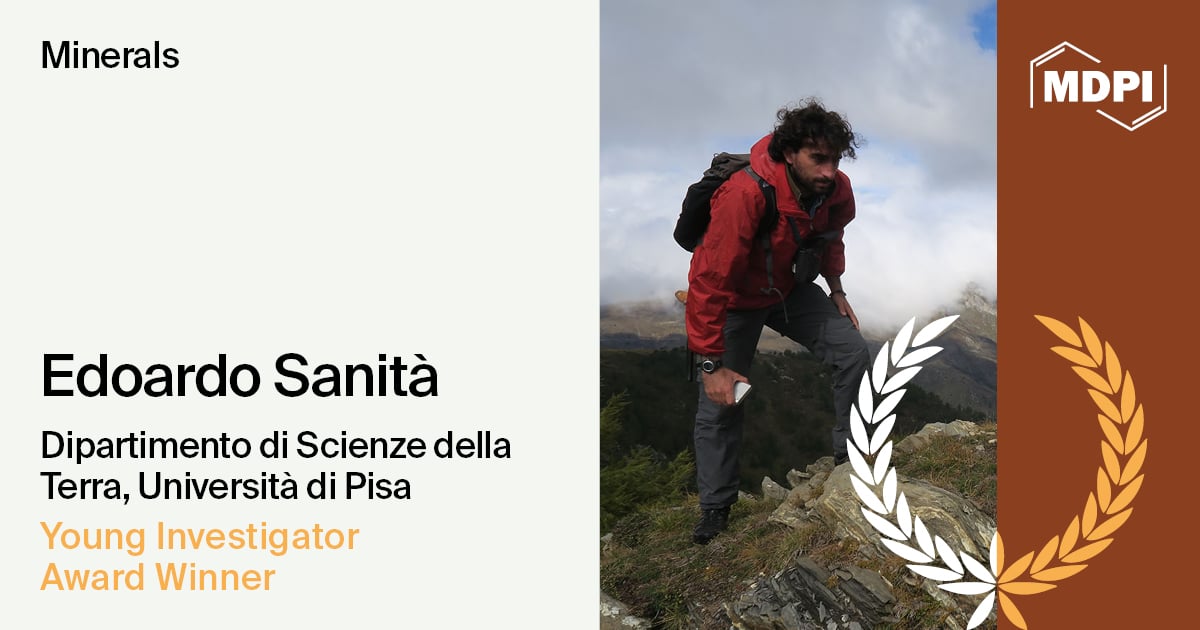
Journal Menu
► ▼ Journal Menu-
- Minerals Home
- Aims & Scope
- Editorial Board
- Reviewer Board
- Topical Advisory Panel
- Instructions for Authors
- Special Issues
- Topics
- Sections & Collections
- Article Processing Charge
- Indexing & Archiving
- Editor’s Choice Articles
- Most Cited & Viewed
- Journal Statistics
- Journal History
- Journal Awards
- Editorial Office
Journal Browser
► ▼ Journal BrowserNeed Help?
Announcements
23 April 2025
Interview with Dr. Edoardo Sanità—Winner of the Minerals 2024 Young Investigator Award

Dr. Edoardo Sanità completed his Ph.D. in structural geology and tectonics at the University of Firenze, Italy, working on the tectono-metamorphic evolution of low-grade units exposed in collisional belts. Subsequently, he moved to the University of Pisa, Italy, as a postdoc researcher where he studied the origin, deformation mechanisms, and metamorphic history of mélanges exposed in the northern Apennines, Corsica, and Western Alps. During this period, he developed advanced strategies with which to unambiguously reconstruct the metamorphic history of low-grade units by merging chemical data from conventional (e.g., EPMA-WDS) and unconventional (e.g., TEM-EDS) devices with forward and inverse thermodynamic modeling and the study of deformation mechanisms from the micro- to nanoscale.
The following is an interview with Dr. Edoardo Sanità:
- Can you briefly introduce yourself to our readers and tell us a little bit about your fields of interest?
I am a postdoc researcher in structural geology and tectonics. My research interests focus on 1) reconstructing the tectono-metamorphic history of subducted rocks, including mélanges; 2) elucidating the deformation mechanism of rock-forming minerals from the micro- to the nanoscale; 3) studying fluid–rock interactions and how these processes control the rheological behavior of rocks deformed and metamorphosed at the depth of the seismogenic zone; 4) developing advanced strategies using conventional (e.g., EPMA-WDS and EDS) and unconventional (e.g., TEM-EDS) devices to unambiguously constrain the pressure and temperature history of subducted rocks by integrating forward and inverse thermodynamic modeling.
- Which research topics do you think will be of particular interest to the research community in the coming years?
In the coming future, the world’s energy security needs will depend less on uninterrupted access to fossil energy sources and more on clean energy technologies, materials, and components.
Attention has been paid to developing a sound methodological approach to addressing energy security through critical core technological elements supporting the respective clean energies. However, the development of advanced strategies aimed at identifying how clean energy technologies, materials, and components can best work is closely linked to rapid and high-quality research. This requires a multidisciplinary approach involving experts from more than one scientific discipline. The geosciences have a key role to play here, as they can provide a comprehensive view of the natural processes responsible for the accumulation of strategic resources useful for the energy transition. Basic research is and will remain essential to improve our knowledge of clean energy, maximize its potential, and ensure a rapid and safe energy transition.
- Have you encountered any difficulties in your research? How did you overcome them?
Surely, the main difficulty is to really understand what your research of interest will be, as I encountered at the beginning of my research life. My scientific curiosity and the will to do something to address societal issues gave me the opportunity to make the right choices on the path to follow up until now.
- Can you briefly describe the key to a happy laboratory life?
In my opinion, the secret to a happy laboratory life is a positive synergy and collaboration between the staff members, as well as a good organization plan.
- What qualities do you think young scientists need?
As a very young early career researcher, I am not sure I am the best person to respond. However, I think that the key driving mechanisms are 1) scientific curiosity based on the fact that a scientist has the responsibility and duty to explore as much as possible in their fields of interest; and 2) to be convinced that, despite a young age, an early career researcher can push forward the current state-of the-art contributing to scientific progress.



